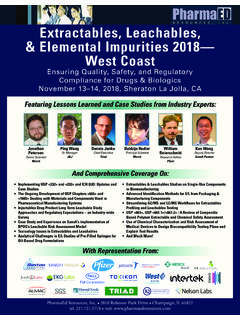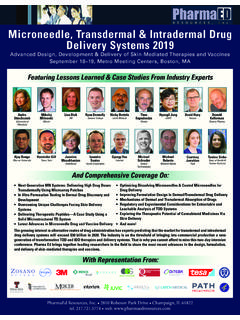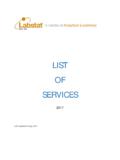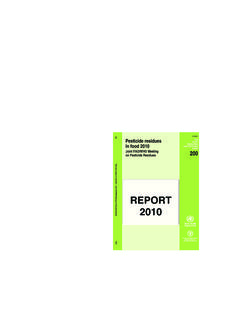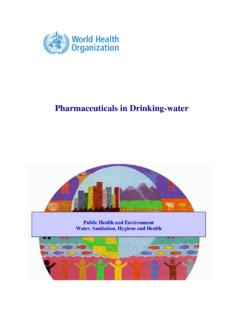Transcription of Extractables, Leachables & Elemental Impurities-West
1 Maximizing E/L Studies Through Aligning USP & ISO 10993 Requirements Leachable Risk Assessment of Dosing Devices for Parenteral Applications Extractables & Leachables Studies on Single-Use Components in Biomanufacturing Addressing Challenges with Polysorbate 80 E&L Test Methodologies for Lyophilized Drug Products Industry Working Group Updates: PQRI & BPOG And Much More!!Extractables, Leachables , & Elemental impurities 2017 West Coast Ensuring Quality, Safety, and Regulatory Compliance for Drugs & BiologicsOctober 24 25, Sheraton La Jolla, CAAnd Comprehensive Coverage On:Featuring Lessons Learned and Case Studies from Industry Experts.
2 A Discussion of USP Chapters <665> and <1665> Dealing with Materials and Components Used in Pharmaceutical Manufacturing Systems - Dennis Jenke, Triad Scientific Solutions Updates & Case Studies on the Latest Compliance Implications of USP <232> and <233> and ICH Q3D Risk Assessment Filing Guidelines for Elemental impurities - Timothy Shelbourn, Research Scientist, Eli Lilly & Smriti Khera, Agilent Technologies- Diego Zurbriggen, West Pharmaceutical Services The Risk Assessment of Extractables A Toxicological Window of Opportunity- William P. Beierschmitt, Research Fellow, Pfizer BPOG s Leachables Best Practice Guide: Study Design and Analytical Methods- Laszlo Litauski, Assoc.
3 Director Challenges & Consequences for the Medical Device Industry by the Revision of Three Major ISO 10993-Standards- Dr. Albrecht Poth, Senior Toxicologist, Dr. Knoell Consult GmbHPharmaEd Resources, Inc. 2810 Robeson Park Drive Champaign, IL 61822tel. web. Representation From:Our Vision is to Help You Realize Yours Register Now to Guarantee Your Space! Online: Phone: , Leachables , and Elemental impurities 2017 West CoastSpectroscopy (ICP-OES) for the analyses. Data process-ing and evaluation was performed using Mass Profiler Professional (MPP) and Microsoft Excel.
4 9:00 Determination of Metal impurities A Practical Approach from the Perspective of A Contract LaboratorySamina Hussain, Senior Chemist/Metal Group Leader, Exova There are several challenges a contract lab faces with the determination of Elemental impurities in finished drug products, APIs, and excipients. Due to the expense and complexity of inductively coupled plasma instrumentation, a contract lab is often contacted by manufacturers to implement compliance with the new Elemental impurities chapters, such as USP <232>, USP <233>, EP , and ICH Q3D. A common issue arising during the method development and validation process concerns setting appropriate specifications for a particular material.
5 An evaluation of the specifications and how they relate to each and every drug product, raw material, and the manufacturing process as a whole is required. In addition, mastering sample preparation and analysis methods for a wide range of materials and specifications requires experience. An understanding of potential interferences associated with the instrumentation and specific analytical approach is essential. A risk-based approach to method validation will be presented. 9:30 The Changing Regulatory Environment Concerning Elemental impurities and Container/Closure SystemsDiego Zurbriggen, Supervisor, Leachables /Stability, West Pharmaceutical ServicesElemental impurities in drug products can arise from multiple sources such as raw materials, excipients, manufacturing equipment and container closure/deliv-ery systems.
6 The Permitted Daily Exposure (PDE) and controls will pose challenges to the industry due to the multiple contributing sources and unique drug product requirements. Risk based approaches for Elemental im-purities are outlined in ICH Q3D and USP <232> and <233> and include specific elements to be consider from any source. Current specifications for extractable elements from elastomers and plastics are defined by USP and EP but these do not encompass all elements of concern. In addition the limits do not translate to drug product dos-ing, so the question remains on how elements of concern can be incorporated into a meaningful drug product risk assessment.
7 The USP is the process of revising chapters for elastomers and addressing these issues. It has been noted that limits for elements will no longer exist, in-stead low levels of elements will be reported as found to be incorporated into a drug product risk assessment. This presentation will provide an overview of a risk-based approach for testing elastomeric closures for this topic. Extraction conditions, method parameters, and re-sults will be , October 24 7:30 Registration & Complimentary Breakfast & Chairperson s WelcomeCritical Issues Updates & Case Studies on the Latest Compliance Implications of USP <232> and <233> and ICH Q3D Guidelines for Elemental impurities 8.
8 00 ICP-OES and ICP-MS Method Development and Validation for the Quantification of Elemental impurities in Large and Small Molecule Drug Substances and ProductsTimothy Shelbourn, Research Scientist, Eli Lilly and CompanyMethodologies have been developed and validated for several small molecule and large molecule drug sub-stances and drug products using ICP-OES and ICP-MS (with collision cell) for various Elemental impurities . A variety of sample types and preparation schemes will be presented including direct organic solvent dissolution, aqueous dilution, and microwave digestion using nitric, hydrochloric and hydrofluoric acids.
9 Elements and their associated toxicological limits were selected from USP <232> and ICH Q3D step 2b. The presentation will include some discussion of compliance strategy and the setting of internal specifications. Methods were validated per ICH Q2r2 and USP <233>. Acceptance criteria for accu-racy, precision, linearity, and range were per USP <233>. 8:30 USP<232> and <233> by ICP-MS and ICP-OES Strategies for Eliminating Common Analytical Challenges and Example Cases StudiesJenny Nelson, Applications Scientist, Agilent; Smriti Khera, Pharma Segment Manager, AgilentStandards and regulations are established to ensure pharmaceutical products are tested to ensure they are safe and effective.
10 As part of these testing requirements, USP<232> (Limits) and <233> (Procedures) calls for con-trolled experiments to verify that storage materials and conditions do not alter the Elemental composition or tox-icity profile of a drug. In this presentation, we will take a look at the latest available ICP-OES and ICP-MS technologies and their relative benefits for Elemental analysis. We will look at what technologies and strategies are most useful for ad-dressing some commonly encountered analytical chal-lenges such as effects of sample matrices, polyatomic interferences and false positives.
